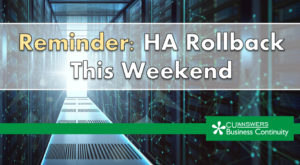For those services and applications where even the slightest amount of downtime has an immediate and measurable impact to our operations; controls and technologies have been implemented to reduce or eliminate the probability of a disruption or to dramatically reduce the amount of time required for recovery. Controls include redundant system and network components, fault tolerant network topologies, load balanced server pools and real-time data replication; all working together to meet and exceed the strict security and availability objectives demanded by today’s users.
The High Availability (HA) strategy at CU*Answers focuses on 24-7 availability for core-processing products and services that our member credit unions depend on including the CU*BASE/GOLD and online/mobile banking platforms. To accomplish this, CU*Answers owns and manages redundant state-of-the-art datacenters fully equipped with redundant power sources, multiple communications service providers, environmental controls, physical access security zones with video surveillance, and centralized network/system monitoring. (SSAE-16 report is available on request for client credit unions.)
High-Availability Rollovers
To ensure our readiness for a critical event affecting our primary processing facility, semi-annual rollover exercises are performed to “redirect” core-processing from systems at our primary datacenter to identical systems at our secondary datacenter. This is a live online event, not a dress rehearsal. Performing this exercise live brings with it the urgency and demand for high performance from our systems and from our recovery teams. This is yet another example of the pressure we put on ourselves in order to best serve our client credit unions.
Due to the nature of these production rollovers, a minimal amount of application downtime is required. This can range from 30-45 minutes, depending on the circumstances of the event. In some cases, should issues arise, actions are taken to collect debug information and/or perform additional checks and audits in order to ensure system and application stability. For these reasons, we schedule rollover exercises during non-peak operational hours. We treat each rollover exercise like a recovery test with full gap analysis reports available for review.
Performing regular HA rollovers helps us to validate our procedures, train new recovery team members, and confirm our readiness and capabilities for those unexpected incidents when unplanned rollovers are necessary. Planned rollovers also allow us to perform routine system and host maintenance with minimal downtime.
View our High Availability Rollover Schedule
Important Instructions for CU*BASE Credit Unions!
Monitoring network connectivity to the secondary datacenter is the responsibility of both CU*Answers Network Services and the credit union. Every time there is a change on your IT network (new branch opens, new PC added, new vendor interface added, firewall or router configuration change, etc.), it brings with it the potential for disrupting access to our secondary datacenter.
For this reason, we recommend that you regularly test connectivity from at least one GOLD workstation at each branch by performing one or both of the following tests:
- TELNET Test
Test connectivity using the TELNET command by following the instructions in this AnswerBook item:
https://kb.cuanswers.com/cuanswers/ext/kbdetail.aspx?kbid=3606 - PING Test
Test connectivity using the PING command by following the instructions in this AnswerBook item:
https://kb.cuanswers.com/cuanswers/consumer/kbdetail.asp?kbid=1930
If the PING or TELNET tests fail, confirm your network’s DNS and IP Routing configuration for compliance with the following AnswerBook items:
- DNS configuration notes: https://kb.cuanswers.com/cuanswers/consumer/kbdetail.asp?kbid=3574
- IP Routing configuration notes: https://kb.cuanswers.com/cuanswers/consumer/kbdetail.asp?kbid=3572
For assistance in troubleshooting network connectivity to the CU*Answers secondary datacenter, please contact a Network Services associate.
![[The Pulse] HA Rollover Results Now Available](https://www.cuanswers.com/wp-content/uploads/The-Pulse-Disaster-Recovery-email-banner-7.21-300x121.png)


















